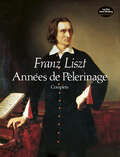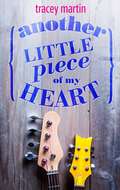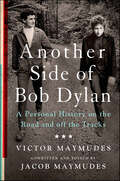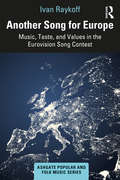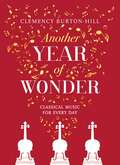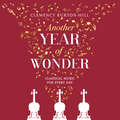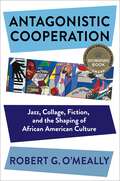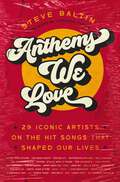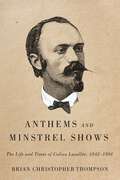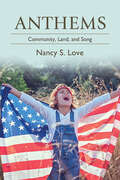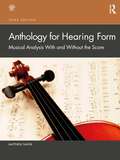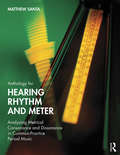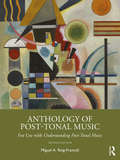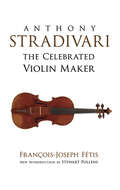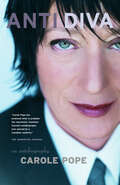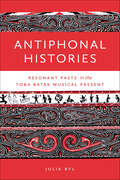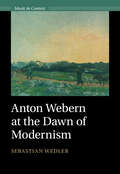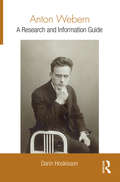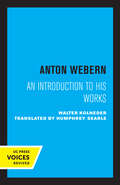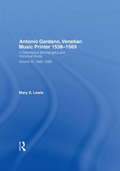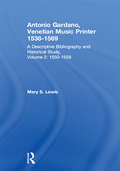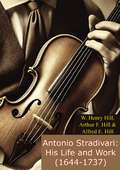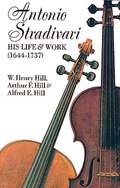- Table View
- List View
Anna's Summer Songs
by Mary Q. SteeleTrees, flowers, ferns, and fruit-- Anna's joyous songs celebrate everything that grows. Delightful children's poetry with picture descriptions present.
Années de Pèlerinage, Complete (Dover Classical Piano Music)
by Franz LisztThe present volume reproduces -- directly from an authoritative Russian edition -- the famous cycle of solo piano works that comprises a summa of Liszt's pianistic achievement, representing the maturation of his style over a period of decades. The Années de Pèlerinage (Years of Pilgrimage) consists of the Première Année(Suisse); DeuxiemeAnnée (Italie) -- including the formidable "Après une lecture du Dante" -- and its supplement, Venezia e Napoli; and Troisième Année. Also included in this volume are a number of related pieces: "Lyon," from Album d'un voyageur; the three pieces called Apparitions; the original version of Venezia e Napoli. In addition, new English translations of the Russian footnotes and of the editor's preface have been provided. Printed in a sturdy, attractive, and inexpensive format, this rich cycle of masterly works for solo piano belongs in the library of every serious pianist or music lover.
Another Little Piece of My Heart
by Tracey MartinWhat if your devastating break-up became this summer's hit single? In this rock-and-roll retelling of Jane Austen's Persuasion, music can either bring you together or tear you apart.At her dying mother's request, Claire dumps Jared, the only boy she's ever loved. Left with a broken family and a broken heart, Claire is furious when she discovers that her biggest regret became Jared's big break. While Jared is catapulted into rock-star status, another piece of Claire's heart crumbles every time his song plays on the radio.The summer after her senior year, it's been months since the big break-up, and Claire is just trying to keep her head down and make it through a tense trip to the beach with her family. But when Jared shows up, and old feelings reignite, can Claire and Jared let go of the past? Or will they be stuck singing the same old refrain?"Sweet, sassy and incredibly swoon-tastic! The romance between these two musicians will strum every reader's heartstrings." - Jennifer Walkup, author of Second Verse"A rocking second chance story layered with wit, music, and heart." - Jean Haus, author of In the Band
Another Side of Bob Dylan: A Personal History on the Road and off the Tracks
by Victor MaymudesA vivid, first-hand account of Nobel Prize-winning singer and songwriter Bob Dylan as an artist, friend, and celebrity, illustrated with never-before-seen photographs, and told by an engaging raconteur who cut his own swathe through the turbulent counterculture.August 2014 marks 50 years since Bob Dylan released his fourth album, Another Side of Bob Dylan. Recorded in one night, in the middle of a turbulent year in his life, the music marked a departure from Dylan's socially-conscious folk songs and began his evolution toward other directions.During the years they spent together, few people outside of Dylan's immediate family were closer than Victor Maymudes, who was Dylan's tour manager, personal friend, and travelling companion from the early days in 1960s Greenwich Village through the late 90's. Another Side of Bob Dylan recounts landmark events including Dylan's infamous motorcycle crash; meeting the Beatles on their first US tour; his marriage to Sara Lownds, his romances with Suze Rotolo, Joan Baez, and others; fellow travelers Ramblin' Jack Elliott, Wavy Gravy, Dennis Hopper, The Band, The Traveling Wilburys, and more; memorable concerts, and insights on Dylan's songwriting process.On January 26th, 2001, after recording more than 24 hours of taped memories in preparation for writing this book, Victor Maymudes suffered an aneurysm and died. His son Jacob has written the book, using the tapes to shape the story. A Los Angeles Times Best Seller.
Another Song for Europe: Music, Taste, and Values in the Eurovision Song Contest (Ashgate Popular and Folk Music Series)
by Ivan RaykoffThe Eurovision Song Contest is famous for its camp spectacles and political intrigues, but what about its actual music? With more than 1,500 songs in over 50 languages and a wide range of musical styles since it began in 1956, Eurovision features the most musically and linguistically diverse song repertoire in history. Listening closely to its classic fan favorites but also to songs that scored low because they were too different or too far ahead of their time, this book delves into the musical tastes and cultural values the contest engages through its international reach and popular appeal. Chapters discuss the iconic fanfare that introduces the broadcast, the supposed formulas for composing successful contest entries, how composers balance aspects of sameness and difference in their songs, and the tension between national genres of European popular music and musical trends beyond the nation’s borders, especially the American influences on a show that is supposed to celebrate an idealized pan-European identity. The book also explores how audiences interact with the contest through musicking experiences that bring people together to celebrate its sounds and spectacles. What can seem like a silly song-and-dance show offers valuable insights into the bonds between popular music and cosmopolitan values for its many followers around the world. From dance parties to flashmobs, parodies to plagiarisms, and orchestras to artificial intelligence, Another Song for Europe will be of particular interest to Eurovision fans, critics, and scholars of popular music, popular culture, ethnomusicology, and European studies.
Another Year of Wonder: Classical Music for Every Day
by Clemency Burton-Hill'Clemency Burton-Hill makes classical music absolutely accessible, magical and medicinal. Another Year of Wonder is, indeed, another wonder.' Dolly Alderton, broadcaster, writer and bestselling author'Clemmie's recommendations have broadened my mind, sharpened my imagination, tugged on my heartstrings and given me a song for every mood. Read this book and let yourself float away for a moment or two. What a gift.' Emma Gannon, bestselling author and host of the Ctrl Alt Delete podcastANOTHER YEAR OF WONDER IS A CAREFULLY CURATED COLLECTION OF CLASSICAL MUSIC OFFERING ONE PIECE TO LISTEN TO EVERY DAY OF THE YEAR.WITH A FOREWORD BY ELIZABETH DAYIn this follow-up to her much-loved Year of Wonder, award-winning broadcaster, journalist and violinist Clemency Burton-Hill continues her mission to demystify and open up the world of classical music to everyone, offering up one extraordinary piece of music to listen to every day of the year.'There is no algorithm to this book: it is a thoughtfully curated selection given from one human to another. It is not a history book, or a formal 'guide to classical music'. It is simply from my heart to yours. I have chosen pieces I love, or think historically interesting, or which have some resonance for me personally or in the world. But what matters is what you think; how they make you feel as you listen. I hope that you will fall in love with most of them, or at least be fascinated by their historical context, or find them curious in other ways, because then you are already in a relationship with classical music. This is your book, as much it is mine.'Another Year of Wonder shows that, whoever you are and wherever you come from, classical music can be a soundtrack for your everyday life and a reminder that finding a space to sit and listen to a piece of music every day can be a singular gift.
Another Year of Wonder: Classical Music for Every Day
by Clemency Burton-Hill'Clemency Burton-Hill makes classical music absolutely accessible, magical and medicinal. Another Year of Wonder is, indeed, another wonder.' Dolly Alderton, broadcaster, writer and bestselling author'Clemmie's recommendations have broadened my mind, sharpened my imagination, tugged on my heartstrings and given me a song for every mood. Read this book and let yourself float away for a moment or two. What a gift.' Emma Gannon, bestselling author and host of the Ctrl Alt Delete podcastANOTHER YEAR OF WONDER IS A CAREFULLY CURATED COLLECTION OF CLASSICAL MUSIC OFFERING ONE PIECE TO LISTEN TO EVERY DAY OF THE YEAR.READ BY EDDIE REDMAYNE, WITH A FOREWORD READ BY ELIZABETH DAYIn this follow-up to her much-loved Year of Wonder, award-winning broadcaster, journalist and violinist Clemency Burton-Hill continues her mission to demystify and open up the world of classical music to everyone, offering up one extraordinary piece of music to listen to every day of the year.'There is no algorithm to this book: it is a thoughtfully curated selection given from one human to another. It is not a history book, or a formal 'guide to classical music'. It is simply from my heart to yours. I have chosen pieces I love, or think historically interesting, or which have some resonance for me personally or in the world. But what matters is what you think; how they make you feel as you listen. I hope that you will fall in love with most of them, or at least be fascinated by their historical context, or find them curious in other ways, because then you are already in a relationship with classical music. This is your book, as much it is mine.'Another Year of Wonder shows that, whoever you are and wherever you come from, classical music can be a soundtrack for your everyday life and a reminder that finding a space to sit and listen to a piece of music every day can be a singular gift.(P)2021 Headline Publishing Group Limited
Antagonistic Cooperation: Jazz, Collage, Fiction, and the Shaping of African American Culture (Leonard Hastings Schoff Lectures)
by Robert O'MeallyRalph Ellison famously characterized ensemble jazz improvisation as “antagonistic cooperation.” Both collaborative and competitive, musicians play with and against one another to create art and community. In Antagonistic Cooperation, Robert G. O’Meally shows how this idea runs throughout twentieth-century African American culture to provide a new history of Black creativity and aesthetics.From the collages of Romare Bearden and paintings of Jean-Michel Basquiat to the fiction of Ralph Ellison and Toni Morrison to the music of Louis Armstrong and Duke Ellington, O’Meally explores how the worlds of African American jazz, art, and literature have informed one another. He argues that these artists drew on the improvisatory nature of jazz and the techniques of collage not as a way to depict a fractured or broken sense of Blackness but rather to see the Black self as beautifully layered and complex. They developed a shared set of methods and motives driven by the belief that art must involve a sense of community. O’Meally’s readings of these artists and their work emphasize how they have not only contributed to understanding of Black history and culture but also provided hope for fulfilling the broken promises of American democracy.
Anthems We Love: 29 Iconic Artists on the Hit Songs That Shaped Our Lives
by Steve Baltin"Anthems We Love is not just a tale of artistic adventure, it's also a manual for artists and fans alike. There is no formula. Just these inspiring stories of the heart . . . " —Cameron Crowe, Academy Award–nominated director, producer, and screenwriter (Jerry Maguire, Almost Famous, Say Anything, and Pearl Jam Twenty)From U2 to Carly Simon, the Temptations to TLC, artists describe in their own words how their songs became the soundtrack of your life in this celebration of music featuring original interviews by acclaimed music journalist Steve Baltin.Which Beach Boys&’ song brings Paul McCartney to tears? What makes &“Light My Fire&” a rite-of-passage song for teens in every generation, according to Doors guitarist Robby Krieger? What is it about music that brings back so vividly the passion of our early loves, our deepest losses, our richest memories?Acclaimed music journalist Steve Baltin examines twenty-nine iconic songs of modern music to ultimately answer: what transforms a song into an anthem? How did these songs become such a part of our culture? Featuring original interviews with superstar musicians like the Beach Boys, Shania Twain, and Earth Wind and Fire, this book offers a detailed celebration of songwriting, fan connections, memorable live performances, and more.A must-have anthology for music fans, Anthems We Love showcases the most beloved and popular songs of all time, including Neil Diamond&’s &“Sweet Caroline,&” the Jackson 5&’s &“ABC,&” Aerosmith&’s &“Walk This Way,&” and TOTO&’s &“Africa.&” More so, it centers the artists behind these songs—and the songs that formed the soundtracks of their lives—as they share stories, for the first time, about how writing an anthem has changed their lives, those of their fans, and our world.
Anthems and Minstrel Shows
by Brian Christopher ThompsonCalixa Lavallée, the composer of "O Canada," was the first Canadian-born musician to achieve an international reputation. While primarily remembered for the national anthem, Lavallée and his work extended well beyond Canada, and he played a multitude of roles in North American music as a composer, conductor, administrator, instrumentalist, educator, and critic. In Anthems and Minstrel Shows, Brian Thompson analyzes Lavallée's music, letters, and published writings, as well as newspapers and music magazines of the time, to provide a detailed account of musical life in nineteenth-century North America and the relationship between music and nation. Leaving Quebec at age sixteen, Lavallée travelled widely for a decade as musical director of a minstrel troupe, and spent a year as a bandsman in the Union Army. Later, as a performer and conductor, he built a repertoire that prepared audiences for the intellectually challenging music of European composers and new music by his US contemporaries. His own music extended from national songs to comic operas, and instrumental music, as he shifted between the worlds of classical and popular music. Previously portrayed as a humble French Canadian forced into exile by ignorance and injustice, Lavallée emerges here as ambitious, radical, bohemian, and fully engaged with the musical, social, and political currents of his time. While nationalism and nation-building are central to this story, Anthems and Minstrel Shows asks to which nation - or nations - Lavallée and "O Canada" really belong.
Anthems and Minstrel Shows: The Life and Times of Calixa Lavallée, 1842-1891
by Brian ThompsonFrom Montreal to New Orleans - the music and complex patriotism of the composer of "O Canada."
Anthems: Community, Land, and Song (SUNY series in New Political Science)
by Nancy S. LoveAn examination of struggles for national sovereignty and social justice as seen through patriotic anthems and songs of resistance.Anthems are songs of loyalty and devotion with religious or quasi-religious meanings, typically associated with nation-states. Singing patriotic songs together encourages a sense of shared identity and unified community among citizens. Anthems compares traditional American anthems, such as "The Star-Spangled Banner" and "America the Beautiful," with anthems of resistance from contemporary social movements, such as Occupy Wall Street, Black Lives Matter, and Standing Rock. Although seldom fully recognized by political scientists, musical song plays a significant role in struggles for national unity and social justice. While America's national anthems celebrate a unitary (white) nation, these alternative anthems challenge the definition of sovereignty as property that characterizes modern Western democracies. They offer an alternative vision of a multicultural democracy still struggling to emerge. Written from an interdisciplinary perspective on culture, economics, and politics best described as critical theory, Anthems is intended for scholars, students, and, most important, citizens.
Anthology for Hearing Form: Musical Analysis With and Without the Score
by Matthew SantaHearing Form: Musical Analysis With and Without the Score, Third Edition is a complete course package for undergraduate courses on musical forms, with comprehensive coverage from the Baroque to the Romantic. Placing emphasis on listening, it teaches students to analyze music both with and without the use of a score, covering phrase endings and cadences, harmonic sequence types, modulations, formal sections, and musical forms. Hearing Form is supported by an integrated workbook section, its own full-score anthology, and a companion website containing an instructor’s manual, test bank, and audio streaming and downloads of recordings for the pieces in the anthology. Key updates in the third edition include: Treatment of phrases and cadences now allows the book to be used by both instructors who teach that all phrases end with cadences, and those teach that some phrases do not New pieces added to the anthology widen the range of composers represented With an engaging and practical approach informed by recent scholarship, Hearing Form enables students to recognize musical elements both by sight and by ear. This is the Hearing Form anthology only. For the Hearing Form textbook, see ISBN 978-0-367-70380-6. For the textbook and anthology package, see ISBN 978-0-367-70391-2.
Anthology for Hearing Rhythm and Meter
by Matthew SantaThis full-score anthology for Hearing Rhythm and Meter: Analyzing Metrical Consonance and Dissonance in Common-Practice Period Music supports the textbook of the same name, the first book to present a comprehensive course text on advanced analysis of rhythm and meter. From the Baroque to the Romantic era, Hearing Rhythm and Meter emphasizes listening, enabling students to recognize meters and metrical dissonances by type both with and without the score. Found here are masterworks carefully chosen as the ideal context for the presentation of foundational concepts. PURCHASING OPTIONS Textbook (Print Paperback): 978-0-8153-8448-9 Textbook (Print Hardback): 978-0-8153-8447-2 Textbook (eBook): 978-1-351-20431-6 Anthology (Print Paperback): 978-0-8153-9176-0 Anthology (Print Hardback): 978-0-367-34924-0 Anthology (eBook): 978-1-351-20083-7
Anthology of Post-Tonal Music: For Use with Understanding Post-Tonal Music
by Miguel A. Roig-FrancolíThis anthology of over 40 scores and excerpts represents a wide range of music from across the twentieth century and into the twenty-first century, from pieces by Debussy, Stravinsky, and Bartok to works by Arvo Pärt, Thomas Adès, and Kaija Saariaho. Showcasing the vast range of compositional styles encompassed in the post-tonal era, this volume offers a convenient compendium including hard-to-find scores. Designed for use with Understanding Post-Tonal Music by Miguel A. Roig-Francolí, which includes extensive analyses of the scores provided here, this anthology can also stand alone for study and analysis in other courses on the history and analysis of post-tonal music.
Anthony Stradivari the Celebrated Violin Maker (Dover Books on Music)
by Stewart Pollens Francois-Joseph FetisRenowned nineteenth-century musicologist François-Joseph Fétis assembled this authoritative survey with the assistance of noted violin maker and dealer Jean-Baptiste Vuillaume. Focusing on the work of the Italian master violin maker Stradivarius, this volume explores the early history and construction of stringed instruments. In addition, this valuable resource provides rare, contemporary glimpses of the world of Paganini, Schumann, and Berlioz. A reprint of a rare 1864 publication, this study offers intriguing historical information to violinists, music historians, and music lovers of all ages. A new Introduction by famed musicologist Stewart Pollens provides further insights.
Anti Diva: An autobiography
by Carole PopeThroughout her career, Carole Pope has blazed a trail for the diva and anti-diva in all of us, and here she offers a no-holds-barred look at her adventures in the music scene – on the concert stage, in the recording studio, and in the bedroom. Known for ushering Canada from the punk movement of the 1970s to the new wave sound of the 1980s with Rough Trade, she candidly shares her thoughts on AIDS, sexuality and sexual politics, and the new breed of music divas that dominates the charts today.
Antiphonal Histories: Resonant Pasts in the Toba Batak Musical Present (Music Culture)
by Julia BylPositioned on a major trade route, the Toba Batak people of Sumatra have long witnessed the ebb and flow of cultural influence from India, the Middle East, and the West. Living as ethnic and religious minorities within modern Indonesia, Tobas have recast this history of difference through interpretations meant to strengthen or efface the identities it has shaped. Antiphonal Histories examines Toba musical performance as a legacy of global history, and a vital expression of local experience. This intriguingly constructed ethnography searches the palm liquor stand and the sanctuary to show how Toba performance manifests its many histories through its "local music"—Lutheran brass band hymns, gong-chime music sacred to Shiva, and Jimmie Rodgers yodeling. Combining vivid narrative, wide-ranging historical research, and personal reflections, Antiphonal Histories traces the musical trajectories of the past to show us how the global is manifest in the performative moment.
Anton Webern at the Dawn of Modernism (Music in Context)
by Sebastian WedlerAnton Webern is recognised as one of the pivotal figures of atonality and precursors to post-war serialism. However, his earlier, tonal works have been largely neglected and shrouded in clichés. A study of both the generative elements of Webern's aesthetic imagination, and the philosophical signatures of musical modernity, this first book-length account of Webern's tonal music explores the complex and variegated ways in which the young composer engaged with, and sought to contribute to, the cultural discourses of fin-de-siècle modernism, well before he self-consciously embarked upon his famous 'path' to the New Music. While acknowledging the rapid stylistic transformation that Webern's musical language underwent, the author suggests that earliness in Webern is not simply a chronological term but is rather best understood in terms of a constitutive tension between phenomenological and dialectical modes of musical thought.
Anton Webern: A Research and Information Guide (Routledge Music Bibliographies)
by Darin HoskissonAnton Webern: A Research and Information Guide offers carefully selected and annotated sources regarding Webern from 1975 to present day, including sources on Webern’s life, his music, and the interpretation and reception of his music. Along with this comprehensive annotated listing of print and online sources, the book discusses the history of research on Webern and includes a brief chronology of his life. It is a major reference tool for those interested in Webern and his music and valuable for researchers of 20th century music and the Second Viennese School.
Anton Webern: An Introduction to His Works
by Walter KolnederThis title is part of UC Press's Voices Revived program, which commemorates University of California Press’s mission to seek out and cultivate the brightest minds and give them voice, reach, and impact. Drawing on a backlist dating to 1893, Voices Revived makes high-quality, peer-reviewed scholarship accessible once again using print-on-demand technology. This title was originally published in 1968.
Antonio Gardano, Venetian Music Printer, 1538-1569: A Descriptive Bibliography And Historical Study, 1550-1559 (A Health Care for Women International Publication #Vol. 2)
by Mary LewisAntonio Gardano's publications are among the most important sources of sixteenth-century music. This final volume in Mary Lewis's three volume set completes the catalogue of Antonio Gardano's publications, covering the years 1560-1569.
Antonio Gardano, Venetian Music Printer, 1538-1569: A Descriptive Bibliography and Historical Study, 1550-1559 (Music Reference Ser. #Vol. 2)
by Mary LewisAntonio Gardano's publications are among the most important sources of 16th-century music. The second volume describes the output of this leading Italian music press in its cultural, bibliographical, and musical context. The first part of the book consists of an overview of Gardano's repertory from the fifties and the cultural and musical milieu in which he worked. It includes discussions of the continuing popularity of his earlier repertory, the music of the younger generation introduced in the fifties, the music of the composers around San Marco, and genres such as the multi-movement madrigal, the canzoni villanesche, instrumental works, and new anthologies. Also discussed are the dating of some undated editions, unconfirmed and doubtful prints, and ordering within the editions. A chapter on binder's copies describes groups of editions bound together by their early owners and serves as a valuable index to the tastes of the collectors. The catalog section covers all Gardano's known publications of the fifties, and provides full titles, bibliographical information, contents with concordant sources for each piece, and locations of individual copies with notes on their bindings, owners' marks, annotations, and other significant characteristics. The catalog is indexed by composer, first line, and short title, and includes a list of primary and secondary sources consulted.
Antonio Stradivari (1644-1737): His Life And Work (1644-1737) (classic Reprint)
by W. Henry Hill Alfred E. Hill Arthur F. Hill, F.S.A.Delve into the fascinating world of violin making with "Antonio Stradivari: His Life and Work (1644-1737)" by W. Henry Hill, Arthur F. Hill, and Alfred E. Hill. This definitive biography offers an in-depth exploration of the life, craftsmanship, and enduring legacy of Antonio Stradivari, the most celebrated violin maker in history.Written by the renowned Hill family, experts in the field of string instruments, this meticulously researched work provides a comprehensive account of Stradivari’s remarkable career. From his early years in Cremona to his rise as the preeminent luthier of his time, the book paints a vivid portrait of Stradivari’s life, his workshop, and the cultural milieu in which he worked."Antonio Stradivari: His Life and Work" delves into the technical aspects of Stradivari’s craft, examining the design, materials, and methods that set his instruments apart. The Hill family’s expertise shines through in their detailed analysis of Stradivari’s violins, cellos, and other string instruments, offering insights into the genius behind their unparalleled sound quality and aesthetic beauty.Richly illustrated with photographs and diagrams, "Antonio Stradivari: His Life and Work" is both a visual and intellectual feast. The Hill family’s passion for and knowledge of their subject make this biography not only an authoritative reference but also an engaging and accessible read.This book is an essential resource for musicians, instrument makers, historians, and anyone interested in the art of violin making. "Antonio Stradivari: His Life and Work" stands as a testament to the enduring legacy of Stradivari’s craftsmanship and the timeless allure of his instruments.Join the Hill family on a journey through the life and work of Antonio Stradivari, and discover the secrets behind the masterpieces that have captivated the world for centuries.
Antonio Stradivari: His Life and Work (Dover Books on Music)
by Francis A. Davis W. H. HillLeading appraisers of fine musical instruments agree that in the art of making violins, no one has ever gone beyond the achievement of Antonio Stradivari. The incomparable visual beauty of his instruments and the infinite variety and magnificence of tone of which they are capable have by this time passed into the realm of legend. Collectors have paid many thousands of dollars for one of Stradivari's violins. It is strange, but true, that only one book really delves into the life and art of this famous Italian craftsman. That is the book published in 1902 by the three Hill brothers of the London violin-making firm. Expert violin-makers and critics of superior violin craftsmanship, these men had unique opportunities to examine and compare almost all of the great examples of Italian violin-making.The larger divisions of the book concern the ancestry of Stradivari; his violins, viols, and violoncellos; his aims in relation to tone; his materials; his varnish; his construction; his labels; the number of instruments he made; the growth of their reputation. Some of the topics discussed under these main headings are: Stradivari's apprenticeship to Amati; comparison of his work with that of Amati; the tone of the pre-1684 Stradivari violin; changes between 1684 and 1690; distinguishing characteristics of many existing violins, violas, and cellos, their specific location, etc.; erroneous views concerning Stradivari's material; his preference for the wood of certain trees in given years; the mystery of the ingredients of Stradivari's varnish; the effect of varnish on tone; the measurements of Stradivari's instruments; the time spent by Stradivari in making a violin; the years of greatest production; the largest number dating from one year; estimate of the total number made; an estimate of the actual sum he charged for an instrument; the introduction of Stradivari instruments into France and England; the first revelation of their supreme merit; and many other interesting topics.Musicologists, violinists, makers of instruments, historians of culture, and those who count themselves simply as music lovers will find this to be an extremely interesting and informative account.

